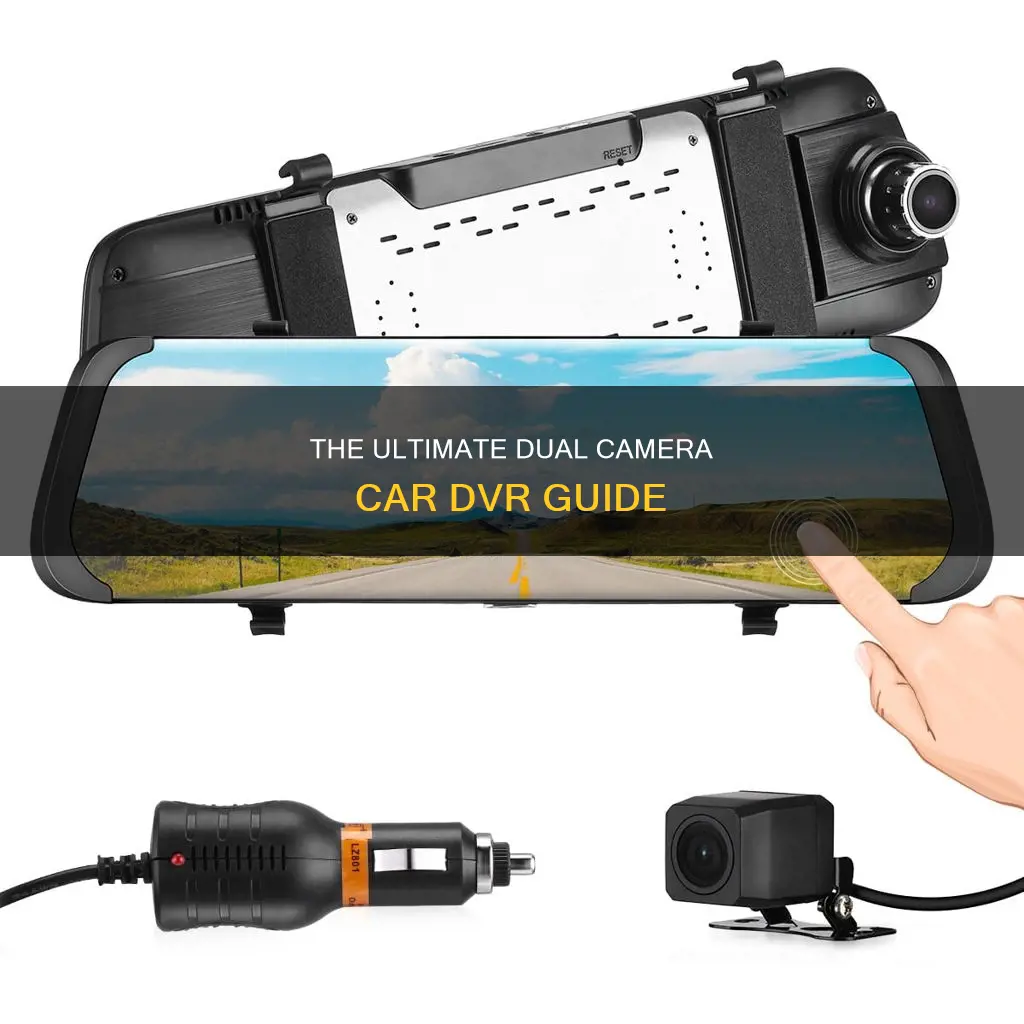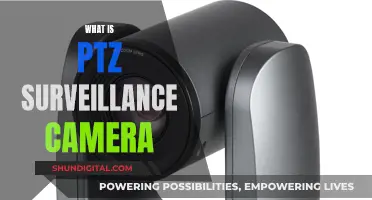
A dual camera car DVR is a device that records video footage from two different angles, typically the front and rear of a vehicle. It is designed to be attached to the windshield or rearview mirror of a car, providing a clear view of the road ahead and behind. Many dual camera car DVRs offer additional features such as night vision, loop recording, G-sensor for collision detection, and support for microSD memory cards for storing recorded footage. Some models also include GPS functionality, allowing drivers to track their vehicle's location, speed, and other data. Dual camera car DVRs are popular among drivers who want to improve their driving skills, record scenic drives, or have evidence in case of a traffic incident.
| Characteristics | Values |
|---|---|
| Display | 2.7-inch LCD screen, 16:9 split-screen |
| Video Resolution | Front: 1080P, Rear: 720P VGA |
| Video Format | .AVI |
| Photo Format | .JPG |
| Memory Card | MicroSD, up to 256GB |
| G-Sensor | Yes |
| GPS | Yes |
| Viewing Angle | 120 degrees |
| Loop Recording | Yes |
| Night Vision | Yes |
What You'll Learn
- Dual-lens dash cams can record inside and outside the vehicle simultaneously
- They can be used as a normal rearview mirror
- They have a built-in G-sensor to detect and record sudden motion
- They support GPS modules to track driving speed and location
- They have night vision and advanced WDR technology for clear images in the dark

Dual-lens dash cams can record inside and outside the vehicle simultaneously
Dual-lens dash cams are a great way to record what's happening both inside and outside your vehicle. This can be especially useful for rideshare drivers, or if you simply want to capture a funny or memorable moment on the road.
Dual-lens dash cams typically consist of a primary front-facing camera and a secondary interior-facing camera. The front-facing camera records the road ahead, while the interior camera captures what's happening inside the vehicle. This setup provides a comprehensive view of your surroundings and can be extremely valuable in the event of an accident or other incident.
One example of a dual-lens dash cam is the Viofo A229 Pro, which offers clear and sharp 4K video quality. It features a supercapacitor for reliable performance in extreme temperatures and includes useful features such as GPS and 24-hour parking monitoring. The Viofo A229 Pro also comes in 1-, 2-, and 3-channel versions, allowing you to add extra cameras to suit your specific needs.
Another option is the Thinkware U1000, which records in UHD 4K at 30fps or 2K 1440p at 60fps. It has a discreet and compact design, and you can add an optional rear camera for a complete dual-lens setup. The Thinkware U1000 also includes useful features like GPS, speed camera detection, and average speed warnings.
If you're looking for a more affordable option, the Miofive S1 and Miofive S1 Ultra offer excellent value. The Miofive S1 provides 4K resolution, GPS, supercapacitor, and 24-hour parking monitoring, all at a budget-friendly price. The Miofive S1 Ultra takes it a step further by adding a 4K rear camera, giving you dual-lens capabilities for a very reasonable cost.
When choosing a dual-lens dash cam, consider your budget, video quality requirements, and the features that are important to you. Some dash cams also offer expandability options, allowing you to add a second camera at a later date. Additionally, pay attention to the installation process, as some dual-lens dash cams may require professional installation to ensure a neat and discreet setup.
Wiring a Car Camera: A Step-by-Step Guide
You may want to see also

They can be used as a normal rearview mirror
A dual-camera car DVR can be used as a normal rearview mirror. These devices replace the standard rearview mirror with an LCD display mirror, which shows a continuous feed from a small camera mounted at the rear of the vehicle. This setup provides drivers with a clear view of what's behind them, enhancing safety and convenience.
The rearview mirror camera offers a clean installation, avoiding any clutter in the driver's line of sight. It also has multiple display modes, allowing for a full-screen display of either the front or rear camera's recording, or a picture-in-picture view from both cameras simultaneously. This ensures that drivers have a comprehensive view of their surroundings.
Additionally, the mirror display can be automatically or manually turned off, allowing the device to function as a standard rearview mirror while still recording. This feature ensures that drivers can use it as a regular mirror when needed, without interrupting any of its recording features.
The installation process for these devices varies, with some mirrors slipping over the existing mirror mount, and others requiring their own mount. Some models also offer rechargeable batteries, while others need to be hard-wired into the vehicle's electrical system.
Overall, a dual-camera car DVR provides drivers with a versatile and functional rearview mirror solution, enhancing safety and convenience on the road.
Iowa's Camera-Based Speeding Tickets: Are They Legal?
You may want to see also

They have a built-in G-sensor to detect and record sudden motion
A dual-camera car DVR is a device that records video footage from two different angles, usually the front and rear of a vehicle. Some models also offer a movable front lens to capture the correct angles inside and outside the car. Many of these devices also come with additional features such as GPS, adjustable viewing angles, low-light functionality, and G-sensors.
G-sensors, or gravity sensors, are an important safety feature in dual-camera car DVRs. They detect and respond to changes in the vehicle's speed and movement by generating a specific signal based on the device's position relative to the Earth's gravitational field. This signal is then sent to a microprocessor that controls the DVR's modes, allowing it to identify and memorise the exact moment of a collision or any abrupt change in speed.
The G-sensor's sensitivity can be adjusted to suit different driving conditions and environments. For example, when driving on uneven terrain, you can lower the sensitivity to avoid unnecessary activations. On the other hand, when parking in an area with a high risk of vandalism, increasing the sensitivity can ensure that even slight bumps or scratches are recorded.
The G-sensor's ability to detect and record sudden motion is particularly useful in the event of a parked car incident. Even if the camera wasn't recording, the G-sensor can trigger it to start, capturing critical footage that can help identify what happened and who was responsible. This automatic function is especially valuable if the driver is unconscious or unable to activate the camera themselves.
The G-sensor's sensitivity is crucial to its effectiveness. A high-quality G-sensor will be highly sensitive and accurate, able to detect even minor changes in motion. This ensures that the DVR responds appropriately, recording crucial footage after an impact without unnecessarily activating due to minor vibrations.
In summary, the built-in G-sensor in a dual-camera car DVR enhances the device's safety features. By detecting and recording sudden motion, it provides valuable evidence for insurance claims and helps drivers understand what happened during an incident. With adjustable sensitivity, drivers can ensure the G-sensor suits their specific driving conditions, making it a versatile and reliable tool for vehicle safety.
Residential Camera Surveillance: Privacy vs. Security
You may want to see also

They support GPS modules to track driving speed and location
Many dual-camera car DVRs support GPS modules to track driving speed and location. These devices are designed to be attached to your windshield, with adjustable lenses to capture video footage from both inside and outside the vehicle. The GPS antenna can be attached to the DVR to record the vehicle's location, speed, and other data, alongside the video footage. This data can then be viewed on a computer using the provided software and a memory card.
Some dual-camera car DVRs with GPS tracking include:
- 70mai Dash Cam Pro Plus+ A500S 1944P GPS ADAS Car Camera
- COOAU Dual Dash Cam 2.5K+1080P
- CAMECHO Dual Dash Cam 1080P Front and Inside Dash Camera
- AZDOME GS63H Dash Cam Dual Lens 4K UHD Recording Car Camera
- 3 Camera Dash Cam 1080P Front and Inside with GPS Vehicle Black Box Driver Recorder for Taxi Uber CAR DVR 720P Rear Camera
Charging Your Kodak Waterproof Camera: A Step-by-Step Guide
You may want to see also

They have night vision and advanced WDR technology for clear images in the dark
Many dual-camera car DVRs come with night vision and advanced WDR technology for clear images in the dark. WDR stands for Wide Dynamic Range, and it's a feature that can significantly enhance the quality of your dash cam footage.
WDR technology allows a camera to capture a broader range of light and dark areas in a single image. This is especially useful when driving in rapidly changing lighting conditions, such as transitioning from a bright, sunny day to a dark tunnel. Without WDR, dash cams may struggle to capture both bright and dark areas in the same image, resulting in footage that is either too bright or too dark to discern details.
WDR achieves this by combining multiple images taken at different exposures and creating a single image with a balanced brightness level. This means that areas that are too bright or too dark in the original footage will be adjusted for better visibility. With WDR, you can capture essential details such as license plates and road signs, even in challenging lighting conditions. This is particularly useful when driving at night or in areas with bright sunlight.
When shopping for a dual-camera car DVR, consider your specific needs. Some models offer additional features such as G-sensors, loop recording, and parking mode. The image and video quality, as well as the camera's ease of use and setup, are also important factors to consider.
Remember, a dual-camera car DVR with WDR can provide valuable evidence in case of an accident or incident on the road. Therefore, investing in a quality device with WDR to ensure clear and reliable footage is worth considering.
Traffic Camera Tickets: To Pay or Not to Pay?
You may want to see also
Frequently asked questions
A dual camera car DVR is a device that records video footage from two different angles, typically the front and rear of a vehicle. It is often used as a dashcam for security and evidence collection in the event of accidents or insurance claims.
Key features include simultaneous recording from two cameras, night vision, loop recording, G-sensor for collision detection, and support for microSD cards for storage. Some models offer additional features such as GPS tracking, motion detection, and parking mode.
Installation varies by model, but typically involves mounting the device on the windshield or rearview mirror, connecting the power supply, and setting up the cameras to capture the desired field of view. Some models may require a more complex installation process, so it is important to refer to the user manual.
Dual camera car DVRs provide a comprehensive view of the vehicle's surroundings, capturing footage from both the front and rear. This can be valuable in the event of accidents, providing evidence of what happened. They can also assist with parking, improving safety, and helping to avoid collisions.







